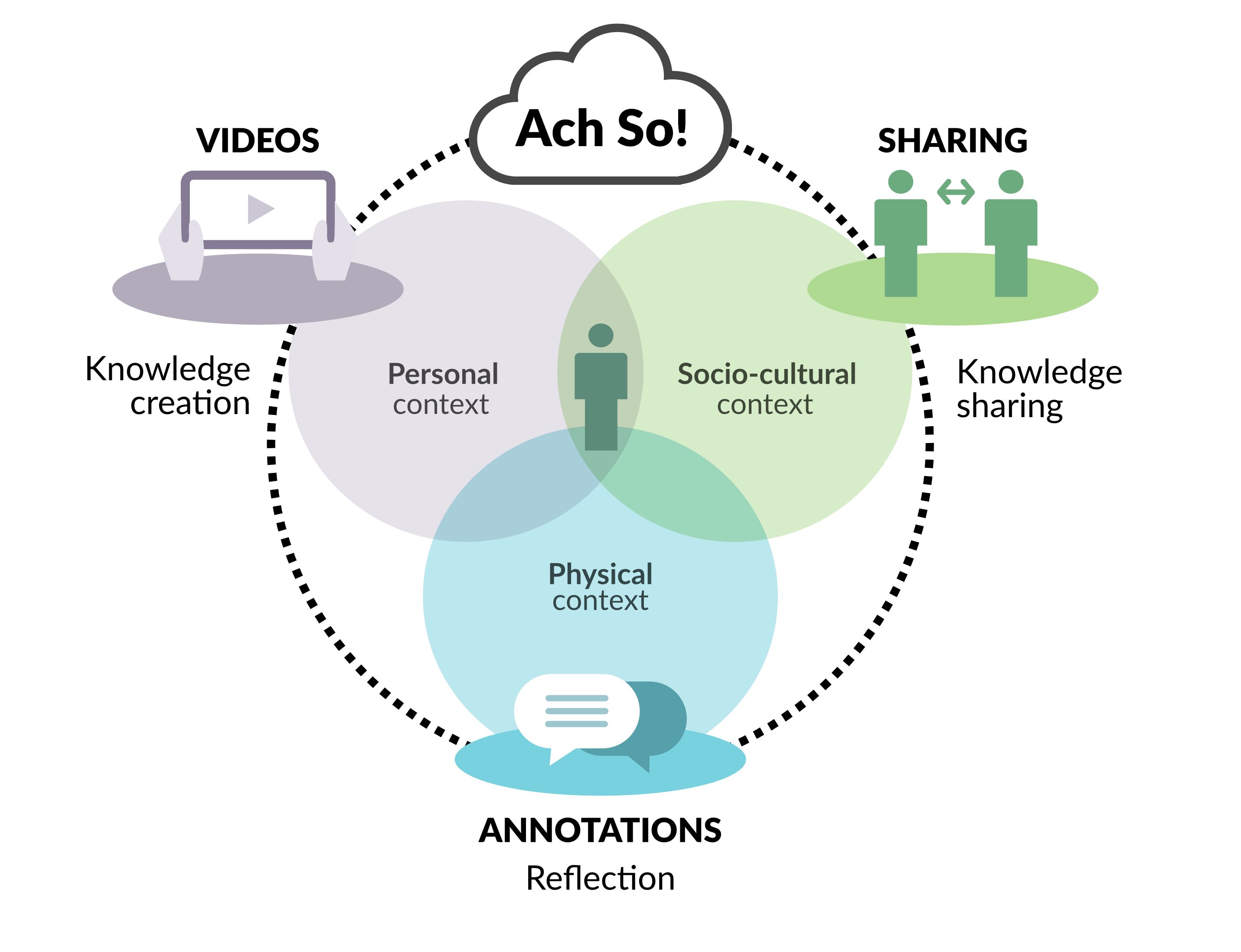Contextual Learning in Construction Industry: Case of Finland
Highlights
-
In order to meet the challenges of the work in the future, organizations have to rethink what learning at work actually is and how to enable learning in situ.
-
The model of contextual learning supports rethinking of informal learning and learning practices at work.
-
Digital technologies make it possible to put the theory-based learning model on contextual learning into the practice and thus enable the transformation of learning practices.
-
In the Learning Layers project, learning and working environment in construction sector was enhanced by using mobile technologies and mobile learning practices.
Context, motivation and contextual learning at work
This scenario on contextual learning is based on outcomes from the pilots at construction sites, several Ach so! and SoAR tool demonstrations, working group meetings in construction sector, discussions with construction professionals, and interviews of tool users in construction trade in Finland. As a part of Ach so! and SoAR pilots at Bau-ABC, contextual learning scenario was applied to German pilots that contributed to improving learning practices in construction sector also in other pilots, such as Learning Toolbox pilot in apprenticeship training. Conclusions and highlights that are presented in this scenario are, however, based on the Finnish context and related international research literature.
Motivation
Construction industry is a trade where working and learning environments are complex and changing even conservative and traditional especially when compared with an agile start-up scene. Working and thus also learning takes place in physical environments where tasks, co-workers and work contexts change and where learning and knowing is tacit, learning happens on the job and is even infrequently spoken about (e.g. [1] [2]). In this kind of working and learning environment, the trade continuously looks for new solutions and practices to safety at work, well-being, workplace training, quality control and transferring innovations from one site to another. The trade is well aware of possibilities that digitalization is providing and uses for instance Building Information Models (BIM) technology, mobile technologies and augmented reality applications for gaining profit and improving competitiveness. The new technologies require new practices and changes in processes that at the end require new skills, competence and learning from workers. Improving the competence and skills of workers requires organizations to rethink about what is learning at work and to redesign how learning happens at work. As for workers, improving competence and skills requires increased awareness about learning and learning activities.
In Finland, contextual learning was applied as a conceptual framework to conduct construction pilots with Ach so! and SoAR mobile applications for enhancing informal learning at work. Contextual learning was not only a standpoint for carrying out the pilots but also for the design and development of mobile applications.
Contextual learning at work
The role of learning at work is still developing and challenging to capture as learning may happen as a by-product in working process or as a recognizable learning in learning process (e.g. [1]). A theory-based paradigm shift from conventional text-based methods of learning to embodied knowing and learning in construction industry can take place through digital technologies and by using a contextual model of learning.
Contextual learning, that includes physical, personal and socio-cultural aspects, reflects modern understanding on learning and provides a conceptual and theoretical platform for transforming practices at work. As a learning paradigm, it is based on constructivist and pragmatist ontologies that emphasize knowledge construction, constructing knowledge on prior knowledge and creating knowledge in interaction with an environment and other people. At construction sites, it means learning in situ in actual working environment, from real working processes and with co-workers. Responsibility for learning is on a learner and instructors or an environment supports the learning process.
Contextual learning at work happens in a physical context that is a construction site as a working environment. Such an environment is changing and dynamic in many ways including tool artifacts to work with, constructions as a target, and people to collaborate with in order to complete the construction tasks. Thus, also learning is connected with that physical environment, with tasks, work processes and people but seldom has a visible identity in the environment. The physical environment emphasizes working processes, not learning processes, which makes learning at construction sites tacit, learned on the job, infrequently spoken, and appearing as a formal written knowledge and informal ways of knowing (e.g. [2]). The physical environment is however authentic and makes a good use of previous professional knowledge and connects it with new knowledge that workers gain on the job.
Contextual learning at work happens in personal context meaning that individual motivation, expectations, prior knowledge, interests and beliefs have an impact on learning. Vocational education and training creates a background and learning on the job extends professional expertise but attitudes and motivation define learning as well. Future learning skills impact also on working at construction sites, which calls for readiness to adapt new knowledge and practices. In the model of contextual learning, mobile learning technologies serve as drivers for achieving new competence and skills but with awareness of learning and reflection on experiences.
Contextual learning at work happens in socio-cultural context, which means that working culture and habits impact on learning. In order to transfer practices and improve informal learning at work, out-of-the-box thinking is necessary. Currently, construction sites are perceived primarily as working environments, not learning environments, which can hide learning and thus be an obstacle to change.
Scenario Description
In construction trade, informal learning and transforming of practices by the above presented contextual model of learning and digital technologies can happen as the following: Construction manager is moving from one site to another to start with a new construction project. In order to be well-prepared s/he familiarizes him/herself with the site by watching visual materials (video, Augmented Reality, AR) with comments that have been created about the site in advance by using Ach so!. The visual material can give a site overview and introduce rules for safety at work, which is expected to decrease the risk for accidents. At the construction site, the construction manager observes a good practice that s/he documents by Ach so! on a mobile device that s/he carries with, points highlights by adding comments to the documentation and shares an observation with co-workers and management, which increase information flow and sharing of knowledge and experiences. Information on a new device and place-specific instructions can be found by QR code search that directs to a repository of video materials. In an urgent problem-solving situation, the construction manager uses a mobile augmented reality app, SoAR, for calling a colleague and communicating the problem through with a shared views and drawing layer on the screen. To make that all happen e.g. organizational commitment to support the use of digital technologies at work, the flow of information top-down and bottom up, and increased awareness of learning activities among working activities are still required.

Figure 1. Contextual learning with Ach so!
Reflections
The conceptual model on contextual learning at work that takes advantage of mobile technologies could serve as a platform for digitalization of learning at workplaces in several trades, including construction. On the other hand, the learning model and related digital solutions describe just the current state that is a kind of transitional period in a whole digital transformation of working and learning.
The initial steps must, however, be taken in order to adapt to changes in working life including digitalization and new requirements for skills and competences in the future work. Future work skills may include e.g. more collaboration, critical thinking and problem solving skills, which in general requires transforming current practices in learning at work – also in construction industry where working and learning environment is fast-changing in terms of physical environment, workforce and the work itself.
Learning at work is a key in transforming practices because by learning workers can improve their skills and capabilities. By learning, they can put also organizational goals in practice and invent new practices to be disseminated in the organization.
Digitalization is a trigger in transforming practices. However, digital technology innovations also require conceptual innovations and a theoretical basis beyond in order to keep the change meaningful – not making a change just because of new technologies available. Thus, contextual model of learning serves also as a justified standpoint for design and development of mobile applications, such as Ach so! and SoAR, in order to create theory-based applications that are designed for certain learning purposes.
The contextual model of learning presented in this scenario provides a conceptual and theoretical background for rethinking and redesigning learning practices at work. Together with digital technologies, that in this case are mobile applications, the model could serve as a platform for shifting conventional text-based methods to embodied learning and knowing ([2]) in construction industry in digital age.
Links to other sections
-
Renewing Practices of Vocational Education and Training for Construction
-
New Communication Practices in Construction Industry and Maintenance Services
-
Organisational Learning and Cooperation at a Construction Site
Further Reading
Contributing Authors
Merja Bauters, Jana Pejoska, Jukka Purma, Teemu Leinonen
References
- M. Eraut, “Learning from other people in the workplace,” Oxford review of education, vol. 33, no. 4, pp. 403–422, 2007.
- S. Pink, H. Lingard, and J. Harley, “Digital pedagogy for safety: the construction site as a collaborative learning environment,” Video Journal of Education and Pedagogy, vol. 1, no. 1, p. 5, 2016 [Online]. Available at: http://dx.doi.org/10.1186/s40990-016-0007-y DOI: 10.1186/s40990-016-0007-y
- M. Virnes and J. Thiele, “Working paper: Applying mobile learning to vocational training at construction sites: barriers and possibilities.,” 2016.
- P. Kämäräinen, “Working paper: WP1/ Work Process Knowledge: Introduction to the reviewing of the legacy of the EU-funded Work Process Knowledge network (FP4 - TSER),” 2016.
- P. Kämäräinen, “Working paper: WP2/ Work Process Knowledge: Revisiting the Theme ‘Work Process Knowledge’ and its implications for vocational education and training - The position the WPK network.,” 2016.
- P. Kämäräinen, “Working paper: WP3/ Work Process Knowledge: Reviewing Work process knowledge - Summary,” 2016.
